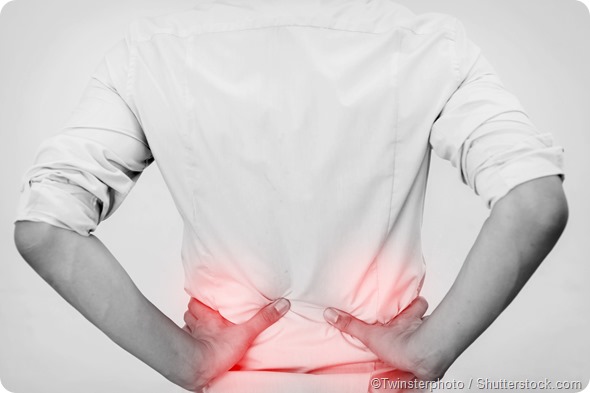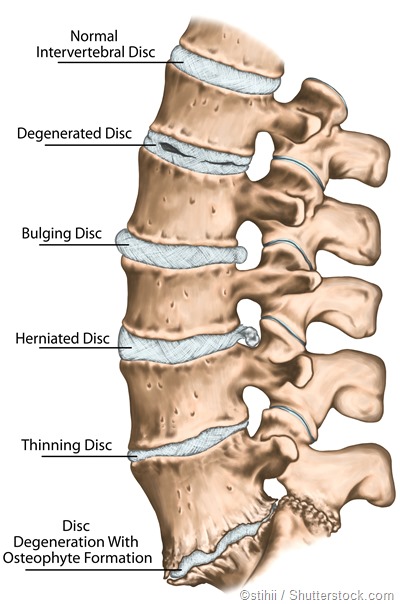Causes of Lower Back Pain
There are many possible causes of lower back pain, with the majority being mechanical in nature. It is often linked to spondylosis, the degeneration of the intervertebral discs of the spine due to everyday wear and tear. Additionally, there are some health conditions that have the potential to cause lower back pain.

The majority of acute cases of lower back pain are linked to sprains or strains of the ligaments, tendons, or muscles, which support the lower back. This usually occurs when an individual moves in such a way as to overstretch the back, or lifts something too heavy, leading to a tear in the connective tissue. An injury from playing sport, a car accident, or any other circumstance, can ultimately lead to compression of the spine, herniated discs and compression of the nerves.
Degeneration of the spine and intervertebral disc
As people age, it is normal for the rubbery intervertebral discs of the spine to lose integrity through a process known as spondylosis. These discs are usually responsible for cushioning the individual bones of the spine as they move on each other during bending and flexion. In elderly individuals, the intervertebral discs are unable to provide this type of support to the lower back area, which can result in lower back pain.
When the intervertebral discs become weakened, any significant degree of compression can lead to a change in positioning which makes them bulge outwards. This is known as herniation. Lower back pain can also result from this.
Spinal stenosis is another condition which causes back pain. It involves narrowing of the spinal column in one area at least. This can lead to an increase in pressure on the surrounding nerves. Spondylolisthesis is another condition in which there is displacement of a spinal vertebra, due to it slipping out of place. This can also press against the nerves and cause lower back pain.

Radiculopathy
If a spine nerve root is compressed, inflamed, or otherwise injured, the pressure on the nerve can lead to pain, numbness or other sensations such as tingling, in various areas of the body, depending on the nerve that was affected. Radiculopathy is the term for this condition, and it is commonly associated with herniated discs that damage a spinal nerve root.
Sciatica is a type of radiculopathy that involves compression of the sciatic nerve, the main nerve to the leg. This is responsible for the transmission of sensation and motor activity to and from the buttocks and down the back of the legs. Sciatica can cause sharp, burning pain in the lower back, buttocks, and (usually) one leg. It can also lead to numbness and weakness of the affected muscles in severe cases.

Underlying conditions
For some patients, lower back pain may present due to an underlying medical condition that should be addressed to manage the pain. Such conditions include:
- Osteoarthritis
- Rheumatoid arthritis
- Osteoporosis
- Endometriosis
- Fibromyalgia
- Kidney stones
- Tumors or cysts
- Infection
- Cancer
Risk factors
Although anyone can be affected by lower back pain, there are some risk factors that increase the likelihood that an individual will develop the symptoms. These risk factors include:
- Age: Most cases initially present between 30 and 50 years of age. The risk increases as people age, due to loss of bone strength and muscle elasticity.
- Fitness: People with low fitness levels are more likely to be affected due to weaker core and abdominal muscles.
- Pregnancy: Pregnant women have a higher risk of lower back pain, due to the hormonal changes which induce changes in the pelvic joints, and increased weight.
- Weight: Excessive weight increases the stress put on the spine and back muscles.
- Family history: Individuals with a family history of related conditions such as spondylitis are more likely to be affected.
- Occupation: People with manual labor jobs that involve heavy lifting, pushing or pulling have a greater risk.
References
- http://www.ninds.nih.gov/disorders/backpain/detail_backpain.htm#3102_3
- http://patient.info/health/nonspecific-lower-back-pain-in-adults
- http://emedicine.medscape.com/article/310353-overview#showall
- http://orthoinfo.aaos.org/topic.cfm?topic=a00311
- http://my.clevelandclinic.org/health/diseases_conditions/hic_your_back_and_neck/hic_Causes_of_and_Initial_Treatment_for_Low_Back_Pain
Further Reading
- All Back Pain Content
- What Causes Back Pain?
- What is Back Pain?
- Back Pain in Pregnancy
- Back Pain Research
Last Updated: Aug 23, 2018

Written by
Yolanda Smith
Yolanda graduated with a Bachelor of Pharmacy at the University of South Australia and has experience working in both Australia and Italy. She is passionate about how medicine, diet and lifestyle affect our health and enjoys helping people understand this. In her spare time she loves to explore the world and learn about new cultures and languages.
Source: Read Full Article
